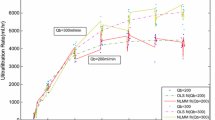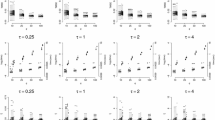Abstract
In the paper, a simple projection-based method is systematically developed to estimate the qth (\(q\ge 2\)) order moments of random effects and errors in the ANOVA type mixed model (ANOVAMM), where the response may not be divided into independent sub-vectors. All the estimates are weakly consistent and the second-order moment estimates are strongly consistent. Besides, the derived estimates are different from those in mixed models with cluster design. Simulation studies are conducted to examine the finite sample performance of the estimates and two real data examples are analyzed for illustration.

Similar content being viewed by others
References
Barameshwar PK, Vashista M (2014) Application of skewness and kurtosis for analysis of Barkhausen noise signal. J Basic Appl Eng Res 1(3):25–29
Chen XR, Zhu LX, Fang KT (1996) Almost sure convergence of weighted sums. Stat Sinica 6:499–507
Cui HJ (2004) Estimation in partial linear EV models with replicated observations. Sci China Ser A 47:144–159
Demidenko E (2004) Mixed models: theory and applications. Wiley, New York
Ebert S (2013) Moment characterization of higher-order risk preferences. Theor Decis 74:267–284
Gluhovsky A, Agee E (2009) Estmating higher-order moments of nonlinear time series. J Appl Meteorol Climatol 48:1948–1954
Jamison B, Orey S, Pruiyy W (1965) Convergence of weighted averages of independent random variables. Z Wahrsch Verb Gebiete 4:40–44
Jiang JM (1996) REML estimation: asymptotic behavior and related topics. Ann Stat 24:255–286
Jiang JM (2003) Empirical methods of moments and its applications. J Stat Plann Inference 33:2695–2731
Jiang JM (2007) Linear and generalized linear mixed models and their applications. Springer, New York
Kutner MH (1974) Hypothesis testing in linear models (Eisenhart model). Am Stat 28:98–100
Kazuhiro T, Yuki H (2008) Comparison of deterioration factor of 6th order moment and cumulant in a Broad Sense. Econ Res Osaka Prefect Univ 54(3):65–81
Li ZX (2011) Estimation in linear mixed models for longitudinal data under linear restricted conditions. J Stat Plann Inference 141:869–876
Li ZX, Chen F, Zhu LX (2014) Variance components testing in ANOVA-type mixed models. Scand J Stat Theory Appl 41:482–496
Miller JJ (1977) Asymptotic properties of maximum likelihood estimates in the mixed model of the analysis of variance. Ann Stat 5:746–762
Nguyen D, Puri TN (2009) Higher order systematic co-moments and ssset pricing: new evidence. Financ Rev 44:345–369
Xu NR (2016) Higher-order moments of economic growth at different stages of financial development (March 30, 2016). Available at SSRN: http://ssrn.com/abstract=2757663
You LY, Nguyen D (2013) Higher order moment risk inefficient futures portifolios. J Econ Bus 65:33–54
Acknowledgements
The authors thank the editor, the associate editor and a referee for their constructive suggestions that substantially improved an earlier manuscript. The research was supported by the National Natural Science Foundation of China (11671398, 11001267, 11261064), the State Key Lab of Coal Resources and Safe Mining (No. SKLCRSM16KFB03), the Fundamental Research Funds for the Central Universities in China (2009QS02), the Beijing Youth Talent Program (No. YETP0945), and a grant from Research Grants Council of Hong Kong, Hong Kong.
Author information
Authors and Affiliations
Corresponding author
Additional information
This research was supported by a grant from the University Grants Council of Hong Kong, Hong Kong, China, and a Grant (NSFC11671042) from the Natural Science Foundation of China.
Appendices
Appendix A: Regularity conditions
Condition C.1: The random errors \(\{\epsilon _i\}_{i=1}^n\) are independent with the same qth order moment \(\gamma _q^\epsilon \) for \(q\ge 2\).
Condition C.2: (1). As \(n\rightarrow \infty \), \(n-rw\rightarrow \infty \) where \(rw=\mathrm{rank} (W)\);
(2) \(rw/n=o(1)\) and \(s_{(n)}=o(n^{-1/4}\text{ log }^{-2}n)\) where \(s_{(n)}=\max _{1\le i \le n} \sum _{1\le j \le n, j\ne i} |l_{ij}|\);
(3) For \(k=1,\ldots ,s\), \(s_{(n)}^{(k)}=o\left( m_k^{-1/4}\text{ log }^{-2}m_k\right) \) where \(s_{(n)}^{(k)}=\max _{1\le j \le m_k} \sum _{j\ne j'} |a_{jj'}^{(k)}|\) with \(a_{jj'}^{(k)}\) being the \((j,j')\)th element of \(Z_k^\mathrm{T}P_{W_{-k}^\bot } Z_k\) [see the identity in (17)].
Condition C.3: The random effects \(\{\alpha _k\}_{k=1}^s\) are independent and independent of the random errors \(\{\epsilon _i\}_{i=1}^n\). Besides, \(\alpha _k\) has independent components \(\alpha _{kj}\) (for \(j=1,\ldots ,m_k\)) with the same qth order moment \(\gamma _q^{\alpha _{k}}\equiv E(\alpha _{k1}^q)=\cdots =E(\alpha _{km_k}^q)\).
Condition C.4: For \(k=1,2,\ldots ,s\), \(\lim _{n\rightarrow \infty } \frac{\sum _{i=1}^n \sum _{i'=1}^n \left( u_{i}^{(k)} {u_{i'}^{(k)}}^\mathrm{T}\right) ^2}{\left\{ \sum _{j=1}^{m_k} \sum _{i=1}^n \left( u_{ij}^{(k)}\right) ^2\right\} ^2}=0\).
Condition C.5: The eigenvalues of \(\{Z_k Z_k^\mathrm{T}\}_{k=1}^s\) are bounded away from zero and infinity.
Condition C.6: There are some positive constants \(c_1\) and \(c_2\) so that \(c_1 \le \mathrm{tr}(Z_k^\mathrm{T}P_{W_{-k}^\bot } Z_k)/m_k \le c_2\) for \(k=1,\ldots ,s\).
Condition C.7: (1) As \(n\rightarrow \infty \), \(\sum _{i=1}^n \sum _{j=1}^n l_{ij}^q \rightarrow \infty \) for \(q\ge 2\);
(2)As \(n\rightarrow \infty \), \(\sum _{i=1}^n \sum _{j=1}^{m_k} \left( u_{ij}^{(k)}\right) ^q \rightarrow \infty \) for \(q\ge 2\).
Condition C.8: There are the finite \((q+\delta )\)th order moments of \(\epsilon _i\) and \(\alpha _{k1}\) with \(k=1,\ldots ,s\) for some positive constant \(\delta \).
Remark 3
Most of the conditions are standard. Conditions C.2(2)(3) are also reasonable. Notice that \(P_{W^\bot }\) is an idempotent matrix and \(s_{(n)}\le \max _{1\le i \le n} l_{ii}\equiv l_{(n)}\). If \(l_{ii}=1\), then \(l_{ij}= 0\) for \(j\ne i\); otherwise, \(0\le l_{ij}<l_{(ii)}<1\). In fact, Condition C.2(2) is the requirement for off-diagonal elements in \(P_{W^\bot }\), which is similar to condition C.3 in Cui (2004). Similarly for Condition C.2(3). Our conditions of establishing the (strong) consistency of estimates may not be the most general, and may be reduced.
Appendix B: Proofs
Some identities and lemmas are introduced first.
Identities:
Notice that the (i, j)th element of \(\left( Z_k^\mathrm{T}P_{W_{-k}^\bot } Z_k\right) ^2\) is \(\sum _{i'=1}^{m_k}u_{i}^{(k)} {u_{i'}^{(k)}}^\mathrm{T}u_{i'}^{(k)} {u_{j}^{(k)}}^\mathrm{T}\). Then
These identities can be easily derived by some elementary calculations, and the details are omitted. They are of interest by themselves and are important to prove the theorems.
1.1 Lemmas:
Lemma 1
(Convergence of weighted sums of independent random variables) Assume that the independent random variables \(\xi _i\) have the same mean \(E(\xi _1)\) and there are positive constants \(b_i\) such that \(\lim _{n\rightarrow \infty } B_n =\infty \) with \(B_n=\sum _{i=1}^n {b_i}\). If \(\lim _{n\rightarrow \infty }\max _{1\le i \le n} b_i/B_n =0\) and \(\sup _{n}\{N(n)/n\} <\infty \) where \(N(n) \equiv \#(i:b_i^{-1}B_i \le n)\) denotes the number of i subject to \(b_i^{-1}B_i\le n\), then \(B_n^{-1} \sum _{i=1}^n b_i \xi _i \mathop {\rightarrow }\limits ^{a.s.} E(\xi _1)\). Moreover, if \(c_1\le b_i\le c_2\) for some positive constants \(c_1\) and \(c_2\), then \(B_n^{-1} \sum _{i=1}^n b_i \xi _i \mathop {\rightarrow }\limits ^{a.s.} E(\xi _1)\).
This lemma can be found in Jamison et al. (1965). \(\square \)
Lemma 2
(Convergence of weighted sums of independent random variables) Assume that \(\xi _1,\xi _2,\ldots ,\xi _n,\ldots \) are i.i.d. random variables with \(E(\xi _1)=0\) and \(E|\xi _1|^r < \infty \) for some \(r\in (1,2)\), the constants \(b_i\ne 0\) for \(i\ge 1\) and \(0<B_1 \le B_2 \le \cdots \rightarrow \infty \). Then if \(\{N(n)/n^r\}=O(1)\) with N(n) defined in Lemma 1, we have \(B_n^{-1} \sum _{i=1}^n b_i \xi _i \mathop {\rightarrow }\limits ^{a.s.} E(\xi _1)\).
This is Theorem 2 in Chen et al. (1996). \(\square \)
Lemma 3
Assume that \(\xi _1,\xi _2,\ldots ,\xi _n\) are independent random variables satisfying \(E(\xi _i)=0\) and \(\sup _i E|\xi _i|^r < \infty \) for some \(r\ge 1\). Let \(\{b_{ij}\}\) be a series of real numbers. Then
where \(s_n=\max _{1\le j \le n}\sum _{i=1}^n |b_{ij}|\), \(d_n=\max _{1\le i,j\le n}|b_{ij}|\).
It is Lemma 3 in Cui (2004). \(\square \)
Proof of Theorem 1
(1) Strong consistency of \(\widehat{\gamma }_2^\epsilon \). Notice that \(\widehat{\gamma }_2^\epsilon =\epsilon ^\mathrm{T}P_{W^\bot } \epsilon /(n-rw)\). For \(i,j=1,\ldots ,n\), let \(l_{ij}\) be the (i, j)th element of the matrix \(P_{W^\bot }\). Then \(l_{ij}\) is the jth element of \(l_i\) defined in the text where \(l_{ii}\ge 0\) and \(\sum _{i=1}^n l_{ii}=n-rw\). Further, \(P_{W^\bot }^\mathrm{T}=P_{W^\bot }\) and \(P_{W^\bot }^2=P_{W^\bot }\) imply \(\sum _{j=1}^n l_{ij}^2=l_{ii}\), which yields \(0\le l_{ii} \le 1\) for all \(1\le i \le n\) and for \(i\ne j\), if \(l_{ij}\ne 0\), \(0<l_{ii}<1\). Notice that
Without loss of generality, assume \(l_{ii}>0\) for \(i=1,\ldots ,n'\) with \(n' \le n\). Thus, \(II_1={\sum _{i=1}^{n'} l_{ii} \epsilon _i^2}/{(n-rw)}\) and \(n-rw=\sum _{i=1}^{n'} l_{ii}\). According to Conditions C.1 and C.2 (1) and Lemma 1, \(II_1 \mathop {\rightarrow }\limits ^{a.s.} {\gamma }_2^\epsilon \).
Further, \(II_2\mathop {\rightarrow }\limits ^{a.s.} 0\). In fact, let \(s_{(n)}=\max _{1\le i \le n}\left\{ \sum _{1\le j \le n, j\ne i}|l_{ij}|\right\} \), \(d_{(n)}=\max _{1\le i\ne j \le n} |l_{ij}|\), and then one has \(d_{(n)}\le s_{(n)}\). According to the nonnegative definite property of \(P_{W^\bot }\), \(0\le d_{(n)} \le s_{(n)} \le l_{(n)} \le 1\) where \(l_{(n)}=\max _{1\le i \le n}l_{ii}\). Then by Conditions C.1, C.2(2) and Lemma 3, \(\max _{1\le i \le n} |\sum _{j\ne i} l_{ij} \epsilon _j|=o(1)\) a.s. Moreover, noting that \(0\le II_2 \le s_{(n)} \cdot \sum _{i=1}^n |\epsilon _i | /(n-rw)\), one has \(II_2\mathop {\rightarrow }\limits ^{a.s.}0\).
(2) Strong consistency of \(\widehat{\gamma }_2^{\alpha _k}\) for \(k=1,2,\ldots ,s\). Recalling (3) and (6), one has
Notice that by the identity (17)
where \(a_{jj}^{(k)}\ge \sum _{j' \ne j} |a_{jj'}^{(k)}|\) by the nonnegative definite property of the matrix \(Z_k^\mathrm{T}P_{W_{-k}^\bot } Z_k\). Thus, similar to the derivation for the strong consistency of \(\widehat{\gamma }_2^\epsilon \) and under Condition C.5, one can obtain \(IIk_{11}\mathop {\rightarrow }\limits ^{a.s.} {\gamma }_2^{\alpha _k}\) by Lemma 1 and \(IIk_{12}\mathop {\rightarrow }\limits ^{a.s.} 0\) by Lemma 3, Conditions C.2(1), C.2(3), C.5 and C.6. These yield \(c_1\le \sum _{j=1}^{m_k} a_{jj}^{(k)} /m_k \le c_2 \) for some positive constants \(c_1,c_2\). Thus, \(IIk_{1}\mathop {\rightarrow }\limits ^{a.s.} {\gamma }_2^{\alpha _k}\).
Further, noting that \(0\le \sum _{j\ne i}|v_{ij}^{(k)}| \le v_{ii}^{(k)}\le 1\), Condition C.2(2) indicates that \(rw_{-k}/n=o(1)\) and Conditions C.2(2),(3) and C.5 imply that \(\tilde{s}_{(n)}=o(n^{-1/4}\text{ log }^{-2}n)\) where \(\tilde{s}_{(n)}=\max _{1\le i \le n} \sum _{j\ne i} |v_{ij}^{(k)}|\), one has \({\sum _{i=1}^n \left( {v_i^{(k)}}^\mathrm{T}\epsilon \right) ^2}/{\sum _{i=1}^n \left( {v_{ij}^{(k)}}^2 \right) }\mathop {\rightarrow }\limits ^{a.s.} {\gamma }_2^\epsilon \). Moreover, Condition C.5 yields \(IIk_3=O(1)\) which leads to \(IIk_2\mathop {\rightarrow }\limits ^{a.s.} 0\). Noting that \(E(IIk_4)=0\) and
one has \(IIk_4 \mathop {\rightarrow }\limits ^{a.s.} 0\) by Conditions C.2(3), C.3, C.5, C.6 and Lemma 3. \(\square \)
Proof of Theorem 2
(1) The consistency of \(\widehat{\gamma }_q^{\epsilon }\) with \(q\ge 2\). According to the derivation of \(\widehat{\gamma }_q^{\epsilon }\), one has
and then it is sufficient to verify
In fact, notice that \(0\le s_1,\ldots , s_n \le q\) and \(s_1+\ldots s_n=q\) with the finite q, for each \((s_1,\ldots ,s_n)\) with finite items, \(\frac{\sum _{i=1}^n \left( \Pi _{j=1}^n l_{l_{ij}}^{s_j} \right) }{\sum _{i=1}^n \sum _{j=1}^n l_{ij}^q}=O(1)\) under condition C.7(1), and then by the consistency of \(\widehat{\gamma }_{s_j}^{\epsilon }\) with \(s_j<q\), (20) is derived, and \(\frac{ \Pi _{j=1}^n \sum _{i=1}^n l_{l_{ij}}^{s_j} \left\{ \epsilon _j^{s_j}-E\left( \epsilon _j^{s_j}\right) \right\} }{\sum _{i=1}^n \sum _{j=1}^n l_{ij}^q}=o_p(1)\) by condition C.7(1) and C.8, which yields (19). (2) The consistency of \(\widehat{\gamma }^{\alpha _{k}}_q\) with \(q\ge 2\). Recalling the estimate \(\widehat{\gamma }^{\alpha _{k}}_q\) in (8), one has \(\widehat{\gamma }^{\alpha _{k}}_q = \widehat{II}_1^{\alpha q} -\widehat{II}_2^{\alpha q} -\sum _{t=0}^{q-1} C_q^t \cdot \widehat{II}_3^{\alpha qt}\) where
and \({II}_2^{\alpha q}\), \({II}_3^{\alpha qt}\), \({II}_{31zi}^{\alpha qt}\), \({II}_{32zi}^{\alpha qt}\) are the corresponding items of \(\widehat{II}_2^{\alpha q}\), \(\widehat{II}_3^{\alpha qt}\), \(\widehat{II}_{31zi}^{\alpha qt}\), \(\widehat{II}_{32zi}^{\alpha qt}\) in which the estimates \(\widehat{\gamma }^{\alpha _k}_{s_{j_k}}\), \(\widehat{\gamma }^\epsilon _{s_{j'}}\) are replaced by their true values \({\gamma }^{\alpha _k}_{s_{j_k}}\) and \({\gamma }^\epsilon _{s_{j'}}\) with \(s_{j_k}=1,\ldots ,q\), and \(s_{j'}=1,\ldots ,q-1\). Besides, notice that \(E\left( \widehat{II}_1^{\alpha q}\right) =E(\alpha _{k1}^q)-II_2^{\alpha q}-\sum _{t=0}^{q-1} C_q^t \cdot II_3^{\alpha qt}\), and by the consistency of \(\widehat{\gamma }^{\alpha _k}_{s_{j_k}}\) in Theorem 1, condition C.7(2) and the fact that q is finite, \(\widehat{II}_2^{\alpha q}-{II}_2^{\alpha q}=o_p(1)\). Thus, it suffices to derive that \(\widehat{II}_1^{\alpha q}-{II}_1^{\alpha q} = o_p(1)\) and \(\widehat{II}_3^{\alpha qt}-{II}_3^{\alpha qt} = o_p(1)\). In fact,
and then by conditions C.1, C.5, C.7(2), C.8, we have \(II_{nt}^{\alpha q}=o_p(1)\) for \(t=0,\ldots ,q\).
For \(t=0\), \(\widehat{II}_{31zi}^{\alpha qt}=1\) and then by the consistency of \(\widehat{\gamma }_{s_{j_k}}^{\epsilon }\) with \(s_{j_k}<q\), the finiteness of q, conditions C.5, C.7(2)
Similarly for \(1\le t \le q\) and by condition C.5 and the fact that \(P_{W_{-k}^\bot }\) is idempotent,
Combining these with the fact that \(\widehat{II}_{31zi}^{\alpha qt} \cdot \widehat{II}_{32zi}^{\alpha qt}-II_{31zi}^{\alpha qt} \cdot II_{32zi}^{\alpha qt}=\left( \widehat{II}_{31zi}^{\alpha qt}-II_{31zi}^{\alpha qt}\right) \cdot \widehat{II}_{32zi}^{\alpha qt}+II_{31zi}^{\alpha qt} \left( \widehat{II}_{32zi}^{\alpha qt}-II_{32zi}^{\alpha qt}\right) \), one has \(\widehat{II}_3^{\alpha qt}-{II}_3^{\alpha qt}=o_p(1)\). \(\square \)
Rights and permissions
About this article
Cite this article
Li, Z., Chen, F. & Zhu, L. Estimating moments in ANOVA-type mixed models. Metrika 80, 697–715 (2017). https://doi.org/10.1007/s00184-017-0623-2
Received:
Published:
Issue Date:
DOI: https://doi.org/10.1007/s00184-017-0623-2




